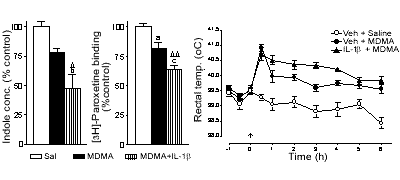| pA2
online © Copyright 2003 The British Pharmacological Society |
054P
University of Surrey Summer Meeting June 2003 |
|
Intracerebroventricular interleukin-1ß exarcebates MDMA-induced neurotoxicity by an additive effect on rectal temperature
|
Print abstract Search PubMed for: O'Shea
E |
3,4-Methylenedioxymethamphetamine
(MDMA or 'ecstasy') produces a long-term degeneration of 5-HT nerve endings
in the rat brain and an acute hyperthermic response which is involved
in the neuronal damage (Green et al., 1995; Colado et al.,
1998). Administration of MDMA to rats induces an acute increase in the
brain levels of interleukin-1ß (IL-1ß) which is partially
dependent on the hyperthermic response induced by the drug (this Meeting).
IL-1ß appears to directly mediate several forms of neuronal damage
and when administered in the brain potentiates ischaemic and excitotoxic
brain damage (Stroemer & Rothwell, 1998; Grundy et al., 1999).
We have now examined the ability of IL-1ß, administered i.c.v.,
to potentiate the long-term loss of 5-HT nerve terminals induced by MDMA
and establish whether this effect is related to changes in the hyperthermic
response.
Male Dark Agouti rats (175-200g) received IL-1ß (5 ng, i.c.v) or
sterile vehicle (5 µl over 5 min) 30 min before MDMA (7 mg kg-1,
i.p.) or saline at room temperature (22ºC). Rectal temperature was
measured throughout. Animals were sacrificed 7 days later and the levels
of 5-HT in cortex and hippocampus and 5-HT transporter density in the
cortex determined by h.p.l.c and [3H]paroxetine
binding, respectively.
MDMA produced no change in ipsilateral cortical 5-HT levels but in the
presence of IL-1ß there was a significant reduction in this parameter
(Figure 1). Similar results were obtained in the ipsilateral hippocampus.
In addition, MDMA caused a significant loss in ipsilateral cortical [3H]paroxetine
binding which was also augmented by IL-1ß pretreatment. These results
were paralleled in the contralateral side. The overall hyperthermic response
induced by MDMA was increased in animals pretreated with IL-1ß such
that although the peak temperature was similar in both groups, the hyperthermia
was maintained above that of MDMA-treated rats for at least 6 h after.
IL-1ß alone also produced a significant increase in rectal temperature
but did not alter either of the 5-HT parameters.These findings indicate
that IL-1ß, when given i.c.v., exacerbates the long-term 5-HT brain
damage induced by MDMA and that this effect is probably due to an additive
effect of the cytokine and MDMA on rectal temperature.

Figure 1. Effect
of IL-1ß (5 ng, i.c.v.) on MDMA (7 mg kg-1,
i.p.)-induced long-term changes (% of control) in ipsilateral cortical
5-HT levels and [3H]paroxetine binding
and on the acute hyperthermic response. The acute hyperthermic response
induced by MDMA (F(1,15)=48.09, P<0.001) was further increased by IL-1ß
pretreatment (F(1,21)=13.48, P<0.01). Results shown as mean
± s.e.mean, n=4-13. Different from saline-treated rats: a,b,cP<0.05,
0.01, 0.001. Different from MDMA-treated
rats: ![]() P<0.05,
0.01.
P<0.05,
0.01.
Colado, M.I. et al., (1998) Br. J. Pharmacol. 124,
479-484.
Green, A.R. et al., (1995) Psychopharmacology 119,
246-260.
Grundy, R.I. et al., (1999) Brain Res., 830, 32-37.
Stroemer R.P. & Rothwell, N.J. (1998) J. Cereb. Blood Flow Metab.
18, 833-839.
M.I.C. thanks MCYT (SAF2001-1437) and FIS (02/1885) and E.O.S thanks UCM
(PR1/03-11653) for financial support.